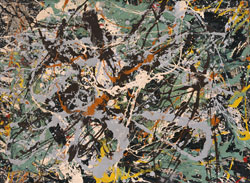1.1
Middle Years Activity
From Edge to Edge: A Practical Activity

Jackson POLLOCK
American 1912–56
Untitled (Green Silver) c. 1949
enamel and aluminium paint on paper, mounted on canvas
57.8 x 78.1 cm
Solomon R. Guggenheim Museum, New York
Gift, Sylvia and Joseph Slifka
© Jackson Pollock/ARS, New York. Licensed by VISCOPY Australia
2004.63
For |
Middle Years Students |
Curriculum |
Visual Arts – Creating and Making |
Think About |
"I don’t work from drawings or colour sketches. My painting is direct…The method of painting is the natural growth out of a need. I want to express my feelings rather than illustrate them. Technique is just a means of arriving at a statement. When painting I have a general notion as to what I am about. I can control the flow of paint: there is no accident, just as there is no beginning and no end." Two styles of Postwar Abstraction in the United States are Abstract Expressionism and Colour-Field Painting. Abstract Expressionism was one of the first important abstract painting styles that emerged in New York in the late 1940s and early 1950s. This group of painters, whose key figures included so-called action painters Jackson Pollock and Willem de Kooning, also became known as the New York School. The dynamism of Pollock’s drip technique, as seen in Untitled (Green Silver) was established after he witnessed sand mandalas of the Native Americans. This inspired him to move his work space away from the vertical to the floor, allowing him the physical space to work ‘in the painting’. |
Aim |
Use the approach of Jackson Pollock to create your own large scale Abstract Expressionist painting. |
Preparation |
To do this activity you will need to collect possible materials:
|
Individual Task |
The aim is not to merely make random marks. Try to control the marks and drips to suggest movement or mood. Some ideas that could be used: Work from beyond the edges, exploring the sense of infinity, space and movement with drips and splashes of paint. Choose the colours carefully. Which colours will help you communicate ‘mood’ within your composition? Think about the way you are moving around the canvas on the floor and how that contributes to the types of marks and gestures you are making with paint. Experiment with a range of different tools to achieve a greater range of different marks. |
Group Task |
Document and discuss with your class the limitations or advantages of having your canvas on the ground and using the paint in this manner. |